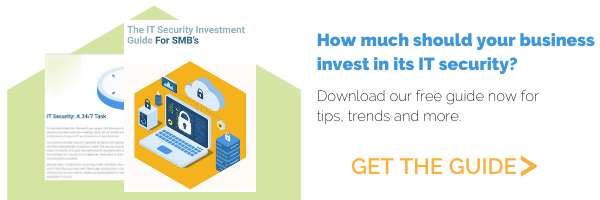How to Protect Yourself Against Network Security Threats and Vulnerabilities

It’s no secret - cyberattacks can be incredibly difficult to recover from. Loss of revenue, reputational damage and intellectual property breaches are all potential consequences which can jeopardise the long-term stability of a business. However, with the right steps, you can overcome these network security threats and vulnerabilities.

When you consider that most companies take nearly six months to detect a data breach and there’s a one in four chance your company could be the victim of one, it’s time to make security threat protection a priority.
- Strengthen Access Control Measures
- Don’t Neglect Physical Security
- Regularly Update All Software
- Standardise All Software in Your Business
- Plug Information Leaks and Use Relevant Network Protection Measures
- Offer Employee Training
- Work With an MSSP
Strengthen Access Control Measures
Access control is a crucial part of security, as weak access control leaves your systems and data more susceptible to unauthorised access which leaves your network more vulnerable. It might sound basic but it’s one of the first lines of defence - boost access control measures by using a strong password system.
Password-cracking technology is quite advanced now so you need to think beyond the basics of numbers and special characters. On the other end of the spectrum, strong passwords can end up on post-it notes dotted around the office so they’re easy to remember, yet more prone to ending up in the wrong hands.
A hacked French network exposed its own passwords during a TV interview while a password for the Hawaii emergency agency was spotted on a post-it note as well. For basic errors like these, cybercriminals don’t even need enhanced technology to cause disruption.
In a place where there’s sensitive data, this isn’t good practice. Start off by creating a strong security and access control policy so employees know what’s expected of them. The stronger your authentication process is and the more gaps you can plug, the more secure your network is likely to be from threats.
Don’t Neglect Physical Security
Although there’s a constant battle to fight hackers and emerging cyberthreats, keeping people away from critical infrastructure can sometimes be enough to prevent incidents.
There have been many global examples of insider breaches taking place. Simply isolating your systems in restricted areas and applying tight access control is a beneficial first step. In Google’s case, it could have stopped an employee plugging a device into the server and downloading thousands of sensitive files.
An alternative is to work with a Managed Security Service Provider (MSSP) where you can outsource networking and storage while benefiting from 24/7 support for peace of mind. At PSTG, we offer just that. We’ve helped many people and organisations like yours to protect their network. Why not take a look at some of our case studies below?
Regularly Update All Software
As frustrating as it can be trying to keep on top of all the software in your business and their relevant updates, they’re vital to the health of your network. From the antivirus you use to the computer operating system you work from, ensure all software is regularly updated and patched so they run on the latest versions.
Although it might be considered basic advice, everyone’s aware of well-known cases of security breaches thanks to organisations using outdated software. Look no further than the infamous WannaCry hack which crippled the NHS due to the health service using outdated systems.
Whenever a provider releases new software, the version typically includes fixes and patches for security vulnerabilities. When you consider that cybercriminals regularly search for new exploits, the longer you ignore recommended updates, the more vulnerable your network is to attacks.
If manual software updates prove to be time-consuming, either configure automatic software updates for as many programs as possible or outsource this task to an MSSP.
Standardise All Software in Your Business
Along with updating all your software, make sure you standardise it throughout your business as well. It helps employees communicate better, especially if you operate in multiple locations so you have reliable data from a single source.
It also means you can spend less time training employees on all the different software you use. If everyone uses the same one, it’s easier to train, more time-effective and helps proficiency. It also means you can spend less maintaining it all, especially if some do the same job.
If you use a lot of software, not knowing which ones your business uses is a big security risk. From operating systems and browsers to antivirus and plugins, make sure all systems operate from the same programs. This ensures everyone works from the same software but it also makes system updates less of a hassle.
Plug Information Leaks and Use Relevant Network Protection Measures
There are many ways sensitive information can flow out of your business. For example, information can leak through emails and the risk only increases if you adopt remote working where staff can access files and information from their own network.
To help combat this threat, combine security policies and technology to limit and reduce the risk of sensitive information leaking out of the business. Protecting your network is crucial so to keep it and the traffic on the network secure, make sure you:
- Install a firewall.
- Ensure thorough access controls have been applied, such as creating a policy which highlights only authorised users can access relevant information.
- Use network segmentation.
- Conduct regular maintenance.
Protecting your network isn’t something you can do once and forget about it. The more regularly you conduct maintenance, the less susceptible you are to vulnerabilities.
Offer Employee Training
Make sure you review your training sessions to ensure employees are aware of security and network best practices and the info you provide is always up-to-date. Like the other steps, this isn’t something you can just achieve once. With new systems and software come new threats, so regular training is a necessity.
More often than not, external threats are usually successful because of an internal error. Even if they’re completely oblivious to it and believe they followed the policies correctly, a small mistake or gap in knowledge can be detrimental.
Ensure staff understand your business’ network security, can quickly identify threats and also know the relevant people to contact to avoid potential security breaches. With new threats emerging every day, employees need to know the tactics and be one step ahead.
Work With an MSSP
The most effective way to protect your network from security threats and vulnerabilities? Work with an MSSP which always focuses on security. It’s their job so when you leave the office at 5pm, you can be safe in the knowledge that experts are maintaining the security of your network.
With a focus on security, outsourcing to a reliable third-party reduces any risks, protects your staff from making errors and also the wider business. At PSTG, we put an emphasis on working with your existing team to help them with their daily challenges. This allows us to create a bespoke solution which plugs any gaps in your network, ensuring it’s always secure and relevant to your unique requirements.
When we have everything up-and-running, we also provide 24/7 technical support so there’s no unplanned downtime and our team works behind the scenes to resolve issues before they can cause any damage.
Partner With PSTG
We do more than suggest patch rollouts. Work with PSTG and you’ll stay protected from cyberattacks, ensure access and control is only given to the relevant people and also train your employees so they can identify threats in the future and know which steps to take.
If you want to find out more about the services we have to offer, don’t hesitate to get in touch with the team today.
But if you want more information on the security landscape and how spending is reacting to growing threats, we’ve also created an in-depth, free guide. We’ve filled it with best practices, helpful tips and a lot more.
To get your free copy, click the link below.






